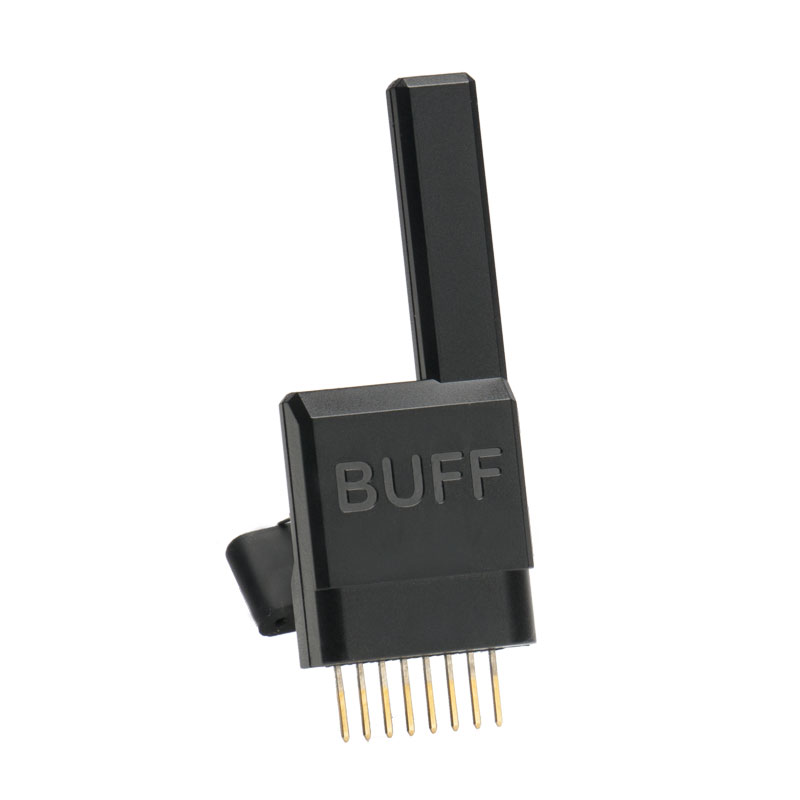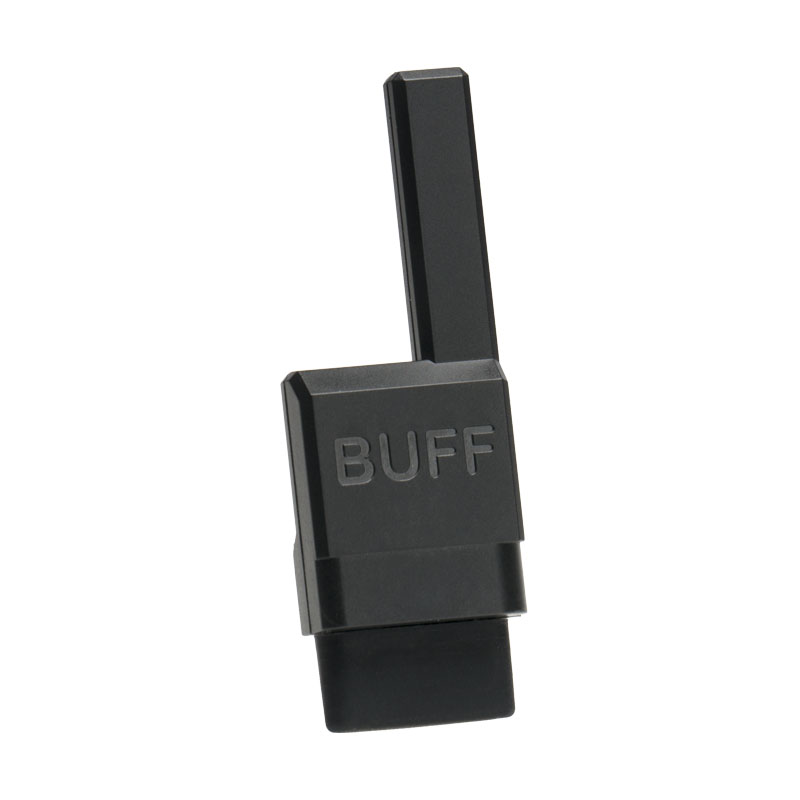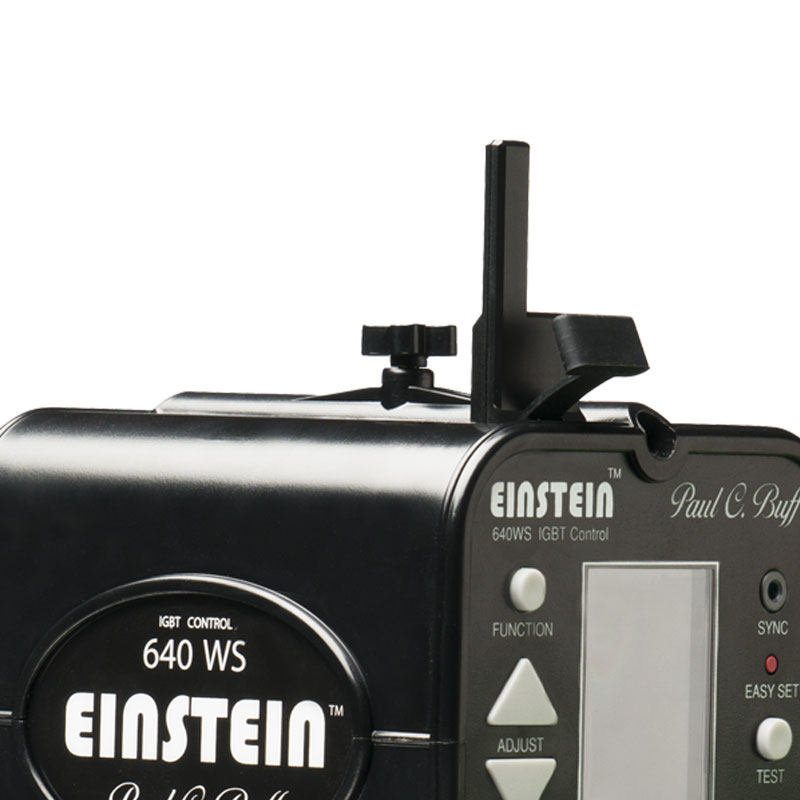- all-digital transmitting receiver (“transceiver”)
- for use with the Cyber Commander™ to control all parameters
- receives signals to control / adjust and transmits status
- can be used with the CST2 Trigger Transmitter for wireless firing
- only for use with the DigiBee and Einstein flash units
- attached rubber pin cover
- 60-Day Absolute Satisfaction Guarantee
- 2-Year Factory Warranty
The CSXCV transceiver (transmitting receiver) is designed for use with DigiBee and Einstein flash units, fitting in the CSXCV transceiver receptacle located on each unit to form an all-digital interface between the flash unit and the CyberSync CST2 transmitters and/or Cyber Commander.
The CSXCV module is powered by the host light unit with frequency and channel selection also performed by the host lighting unit. This makes the CSXCV module truly plug-and-play, unleashing the full power and accuracy of a sophisticated all-digital remote control system.
The CSXCV receivers facilitate adjustment of flashpower and other parameters when used with the Cyber Commander™ transmitter. When signaled by the CST2 Transmitter, the receivers will only serve to fire the units to which they are attached.
The CSXCV module is powered by the host light unit with frequency and channel selection also performed by the host lighting unit. This makes the CSXCV module truly plug-and-play, unleashing the full power and accuracy of a sophisticated all-digital remote control system.
The CSXCV receivers facilitate adjustment of flashpower and other parameters when used with the Cyber Commander™ transmitter. When signaled by the CST2 Transmitter, the receivers will only serve to fire the units to which they are attached.
| Physical Dimensions | |
| Cyber Commander™ | 2" width x 4.75" height (including antenna) x 0.75" depth 1.5" x 2" LCD screen |
| CST2 Transmitter | 1" width x 3.1" height x 0.6" depth |
| CSR / CSR+ Receivers | 2.25" width x 4" height x 1" depth (plus 10” cord) |
| CSRB Receiver | 1.375" width x 4" height x 1.125" depth |
| CSRB+ Receiver | 1.75" width x 4" height x 1.25" depth |
| CSXCV Transceiver | 1" width x 2.75" height x 0.375" depth |
| System Specifications | |
| System Frequency Range | 16 frequencies spaced 2MHz apart, from 2.427GHz to 2.457GHz |
| System Encoding | secure 256-bit binary encoded packet, with validity verification |
| System Latency | 1/4000 typical delay from closing of camera contact to receiver sync output signal |
| Battery Life - Cyber Commander™ | 6.5 to 8.5 hours under normal use with premium alkaline batteries (uses two AAA alkaline or lithium batteries) |
| Battery Life - CST2 Transmitter | 2 years under normal use (uses lithium coin cell CR2032 battery - 3VDC, 240mAH) *more common battery to find |
| Battery Life - CSRB and CSRB+ | approx. 200 hours on-time with premium batteries (uses two AA alkaline or NiMH batteries) |
| Sync Voltage | less than 4VDC at camera with Cyber Commander™ and CST2 Transmitter; receivers withstand up to 300VDC from a connected flash unit |
- the CSXCV plug-in module
- your CyberSync™ instruction manual
With the CyberSync™ system, the CSXCV transceiver is connected to the flash unit(s) in your setup and requires a transmitter at the camera position. As the CSXCV has a drop-in connection for second generation Paul C. Buff™ lights, it is only compatible with the DigiBee flash units (DB400 and DB800) and Einstein E640 flash unit.
The CSXCV receivers are compatible with both the CST2 Trigger Transmitter and the CC Cyber Commander™. The CSXCV receivers, however, can only receive cues to fire from the CST2. With the Cyber Commander™, they can receive commands for firing, flashpower adjustment and control of all other parameters.
For a complete setup that cues firing, flashpower adjustment and control of all other parameters, you will need one Cyber Commander™ transmitter at the camera position and one receiver (either CSXCV, CSR+ or CSRB+) for each light in your setup.
For a triggering setup, you will need one transmitter (either the CST2 or the Cyber Commander™) and at least one receiver (CSR, CSRB, CSR+, CSRB+ or CSXCV). When just one receiver is used, other units in the setup can be fired simultaneously via their built-in slave trippers. If you will be working in an environment where other photographers and flashes can inadvertently trip your lights, you can use one receiver for each light in the setup. You can mix receivers in your setup (using one CSR, one CSRB+ and one CSXCV, for example) - you will simply need to ensure that all receivers are set to the same frequency.
The CSXCV receivers are compatible with both the CST2 Trigger Transmitter and the CC Cyber Commander™. The CSXCV receivers, however, can only receive cues to fire from the CST2. With the Cyber Commander™, they can receive commands for firing, flashpower adjustment and control of all other parameters.
For a complete setup that cues firing, flashpower adjustment and control of all other parameters, you will need one Cyber Commander™ transmitter at the camera position and one receiver (either CSXCV, CSR+ or CSRB+) for each light in your setup.
For a triggering setup, you will need one transmitter (either the CST2 or the Cyber Commander™) and at least one receiver (CSR, CSRB, CSR+, CSRB+ or CSXCV). When just one receiver is used, other units in the setup can be fired simultaneously via their built-in slave trippers. If you will be working in an environment where other photographers and flashes can inadvertently trip your lights, you can use one receiver for each light in the setup. You can mix receivers in your setup (using one CSR, one CSRB+ and one CSXCV, for example) - you will simply need to ensure that all receivers are set to the same frequency.




